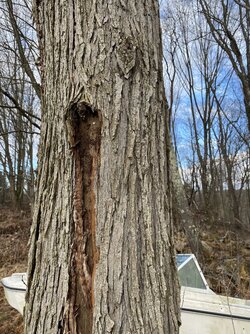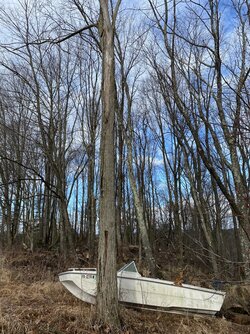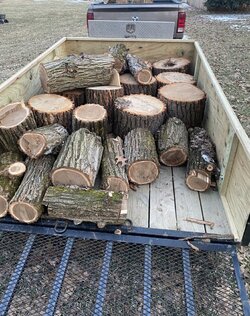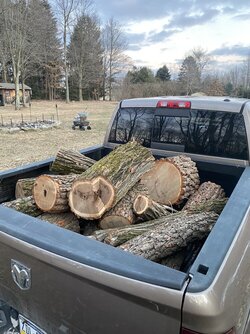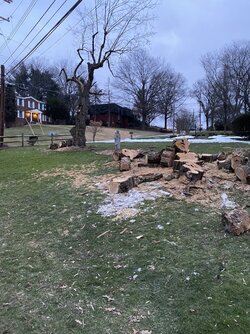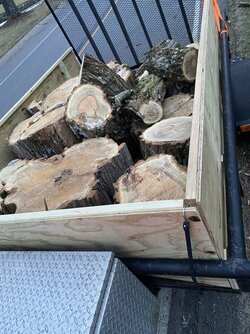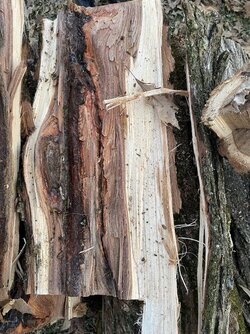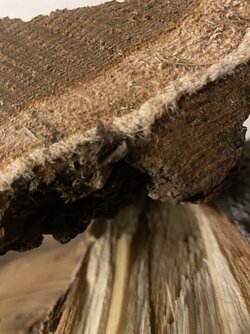Tree ID and think it’s burn worthy?
- Thread starter Littledog
- Start date
-
Active since 1995, Hearth.com is THE place on the internet for free information and advice about wood stoves, pellet stoves and other energy saving equipment.
We strive to provide opinions, articles, discussions and history related to Hearth Products and in a more general sense, energy issues.
We promote the EFFICIENT, RESPONSIBLE, CLEAN and SAFE use of all fuels, whether renewable or fossil.
You are using an out of date browser. It may not display this or other websites correctly.
You should upgrade or use an alternative browser.
You should upgrade or use an alternative browser.
nrford
Minister of Fire
jackatc1
Feeling the Heat
hickoryhoarder
Minister of Fire
CincyBurner
Minister of Fire
IMO looks like Am elm (general form constant for elm, bark, and dead top - DED ?).
Am elm bark has distinctive alternating buff/ brown layers when sliced with knife (spongy when young).
https://dendro.cnre.vt.edu/dendrology/syllabus/factsheet.cfm?ID=41
If DED look for characteristic elm beetle infestation - larval gallery.
https://ohioline.osu.edu/factsheet/plpath-tree-04
Am elm bark has distinctive alternating buff/ brown layers when sliced with knife (spongy when young).
https://dendro.cnre.vt.edu/dendrology/syllabus/factsheet.cfm?ID=41
If DED look for characteristic elm beetle infestation - larval gallery.
https://ohioline.osu.edu/factsheet/plpath-tree-04
CincyBurner
Minister of Fire
Caw
Minister of Fire
Caw
Minister of Fire
Am I the only one who questions if the wood in the pick-up is Black Locust ? I hope it is , just looks suspect to me.
CincyBurner
Minister of Fire
MongoMongoson
Feeling the Heat
You are not the only one. I say it is red elm in the pickup truck. Red elm is pretty good firewood.Am I the only one who questions if the wood in the pick-up is Black Locust ? I hope it is , just looks suspect to me.
Caw
Minister of Fire
All these suggestions are primo firewoods so regardless you got a good score. Splitting difficulty and smells will help narrow it down.
MongoMongoson
Feeling the Heat
I don't see much black locust, but when I saw the picture I thought "red elm". Red elm has a distinct aroma and that white layer between the outer bark and sap wood will feel "slippery" when wet. Red elm is also called slippery elm. If you split by hand, and it is red elm, don't aim for the center. Go off center a little bit and you'll be able to bust slabs off the heart wood.
That looks more like black locust to me , see the greenish / yellow . Did you see any seed pods around this tree ?Not far from the other load. Is this locust?!?
Yes I went by on my way home from work and I found seed podsThat looks more like black locust to me , see the greenish / yellow . Did you see any seed
Snapped pics of stumps after work. So I got home and decided to sort through the wood and I think I have 3 different species here.
Picture 1 is definitely locust. Split rather easily, moisture on a fresh face is only 22-24 (32 degrees F)
Picture 2 and 3 is red elm?? Vibrant colored bark, very prominent smell, split very easy (moisture only 20?)
Picture 4 and 5 black walnut? Smells very very similar to the locust. A little challenging to split, stringy (Moisture 33-38)
Either way I’m very happy with these hauls and appreciate everyone’s input! My first year of scrounging
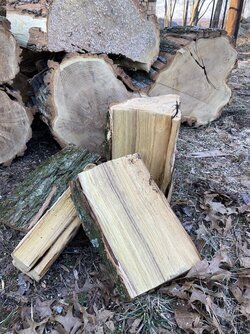
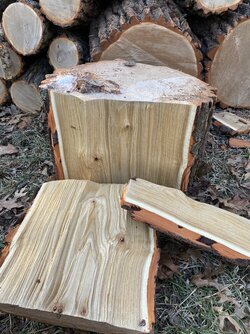
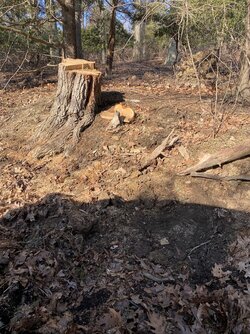
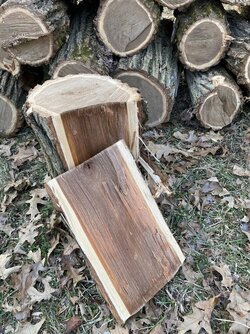
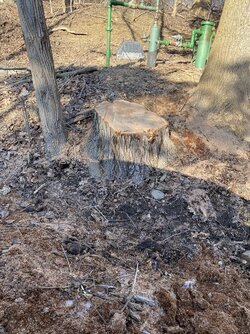
Picture 1 is definitely locust. Split rather easily, moisture on a fresh face is only 22-24 (32 degrees F)
Picture 2 and 3 is red elm?? Vibrant colored bark, very prominent smell, split very easy (moisture only 20?)
Picture 4 and 5 black walnut? Smells very very similar to the locust. A little challenging to split, stringy (Moisture 33-38)
Either way I’m very happy with these hauls and appreciate everyone’s input! My first year of scrounging





Last edited:
Last edited:
CincyBurner
Minister of Fire
Now this (post #19) looks like black locust (Robinia pseudoacacia): blocky gray bark, heartwood green-yellow with light band of sapwood. The blue-green cast leaves are double compound. Twigs are have armed with double spines. Your load has distinctive Fomes heart rot, a decay pathogen, ubiquitous on older black locust specimen (conks/ fruiting bodies on the outside (bark) of tree..Not far from the other load. Is this locust?
Black locust is a good tree to learn by smell. Since it is in the pea family it emits a very distinctive smell of pea or bean when fresh cut or split.
Great firewood, once properly seasoned !
Similar threads
- Replies
- 30
- Views
- 4K
- Replies
- 19
- Views
- 2K


